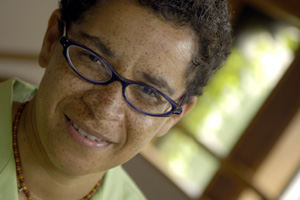Goldsby to bring city’s early, black literary scene out of Harlem’s shadow
By Josh Schonwaldjschonwa@uchicago.edu
News Office
 Photo by Dan Dry Jacqueline Goldsby |
|
It’s not as well known as the Harlem Renaissance of the 1920s, but the Chicago Renaissance produced a tremendous flowering of African-American writing during the 1930s, ’40s and ’50s. Richard Wright, Margaret Walker, Gwendolyn Brooks and Lorraine Hansberry are just a few of its stars.
Jacqueline Goldsby, Associate Professor in English Language & Literature and the College, will devote her Humanities Day keynote address to exploring one of the key differences that distinguished the Chicago Renaissance from Harlem’s more famous movement. Her talk begins at 11 a.m. on Saturday, Oct. 25 in Mandel Hall.
“There was a degree of broad-based community involvement in the literary arts here,” said Goldsby, who studies early- to mid-20th-century American and African-American literature. “Renowned writers such as Wright, Walker and Brooks often apprenticed themselves in neighborhood-based collectives that nearly always included ‘amateur’ poets, novelists, dramatists, critics and painters. There was a mixing of ‘highbrow’ literary figures with the working class and ‘middlebrow’ masses in Chicago that didn’t happen as fluidly in New York,” Goldsby said.
Goldsby’s lecture will focus on one of the most important manifestations of this more egalitarian Chicago-style renaissance: the Book Review and Lecture Forum, anchored at the Chicago Public Library’s George Cleveland Hall Branch in the heart of the city’s Bronzeville neighborhood.
Vivian Harsh, the first African American to head a Chicago branch library, spearheaded the series in 1933; it ran strong for two decades.
These gatherings drew black authors—local and national, well established and emerging—into face-to-face dialogue with Chicago’s black reading public. “Hundreds turned out to hear Richard Wright, Langston Hughes, Gwendolyn Brooks, Walker and Hurston read from their latest works and works in progress,” said Goldsby, “while critics led discussions about the ‘great books’ and the ideas of those times.”
In her lecture, Goldsby aims to discuss the University’s influence on the Hall Branch. Philanthropist Julius Rosenwald provided two pivotal grants to fund the library, and Harsh not only consulted with the University’s Library School (now closed) to conduct patron surveys, but also modeled the Forum after Chicago’s “Great Books” core curriculum.
Through the case of the Hall Branch, Goldsby also will look at the uniqueness of the Chicago Renaissance, comparing the events hosted in Hall Branch to those in Harlem during the 1920s.
“Vivian Harsh deliberately aimed to mix ‘highbrow’ literary figures and discussions with the working class and ‘middlebrow’ masses,” said Goldsby. “I’m intrigued by the possible regional case to this difference. The Book Review and Lecture Forum’s ‘Midwestern’ approach of communal, non-hierarchical, non-elite exchange represented a decisive break from the East Coast’s tradition of privatized, enclosed, exclusionary dialogue, particularly within African-American literary societies.”
Goldsby, who is the author of the award-winning A Spectacular Secret: Lynching in American Life and Literature, is researching Hall Branch Library for a forthcoming book. She hopes her attention to “Black Chicago’s Book Review and Lecture Forum” will ultimately have a broad impact on literary scholarship. “I hope it will shed light on the creative scope and consequences of writing the histories of ‘renaissance’ movements, not only in African-American literary history, but in American literary history as well.”
![[Chronicle]](/images/sidebar_header_oct06.gif)